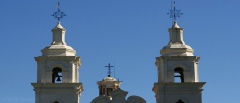Culture: Cordoba
The city of learning is steeped in Jesuit history and culture
As a centre for the Jesuits of the 1500s, Cordoba as a city is an interesting blend of the new and the old. Seen as the educational capital of Argentina ever since, it houses no less than 7 different universities. As a cultural destination it is very interesting, both in the city itself and in the surrounding countryside. The main reason to come here is certainly for the Jesuit ruins that lie just outside.
To start with, the city itself has a whole host of interesting churches and buildings to take and a look at, all within walking distance from one another.
Manzana Jesuitica (“Jesuit block”)
One of the main structures in the city, it was constructed by the Jesuit order as a centre for prayer and learning in the city. Completed in 1671 the highlight of a visit here is the church, the Iglesia de la Compania de Jesus, which is a fascinating combination of architectures and features, as its centre piece, what was designed as an inverted ship for a roof.
Also in the block is the Capilla Domestica or domestic chapel which again, has an interesting roof, made out of stretched cowhide and ornately decorated using pigmentation made, in part, from bones.
Universidad Nacional de Cordoba library
Argentina's oldest library, this is another highlight of Cordoba, and it still houses some of the original books brought across by the Jesuits. On the whole, we recommend taking guided tour around the city centre as there is plenty to see and do.
Outside of the city, heading up to the Sierras Chicas, the Jesuits had also constructed several small monasteries that are, to this day, still in their original condition. Probably the most beautiful of these is the monastery of Jesus Maria, which is often visited on the way into the hills.

